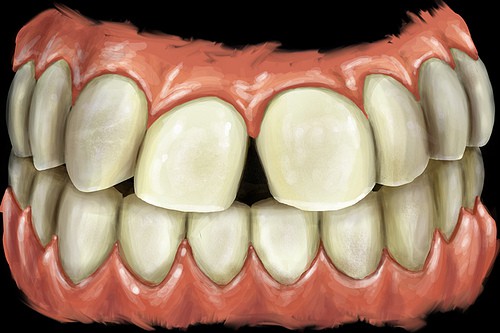Receding Gums With Braces – Dental Care Guide
Last Updated on July 4, 2023 by Gio Greenard
Receding gums are a common dental issue that affects many individuals. While often considered a cosmetic problem, receding gums can lead to serious health problems if not addressed properly. In this blog post, we will discuss the connection between braces and receding gums, and explore the various ways to manage this condition. We will also provide some helpful tips on how to maintain good oral hygiene and prevent further gum recession.
Very Bad, Receding Gum Line. Best Options?

Simon Wilches via Compfight cc
One of the major health problems facing women as their age is receding gum lines. The severity of this problem is often overlooked until the symptoms are glaring and causing continual discomfort. In fact, 60% of women will face the problem of gingivitis sometime in their life. There are many causes of a receding gum line. These include the following:
- Periodontal diseases. Bacteria that builds up along your gum line and eats away at the bone and tissue.
- Your Genes. Thirty percent of the population is susceptible to receding and sensitive gums.
- Build up of plaque: This can result from not taking preventative care seriously. Taking the time to brush and floss prevents the build up of plaque.
- Women’s Life Changes: The hormonal issues that women face can cause the mouth and gums to become more sensitive. This can include menopause, pregnancy and pre-menopause.
- Improper Teeth Brushing: Using the wrong toothbrush, not flossing and brushing too hard can weaken gum tissue.
- Other issues can include a misaligned bite or grinding your teeth together when you sleep. Smoking and tobacco use also cause plaque build up.
Recognizing and treating the symptoms of gum disease are important to prevent further problems. The symptoms of gum disease are:
- Bleeding gums during and after when the teeth are brushed.
- Gums that are swollen, tender and darker than usual.
- Gums that are visibly pulling away from the teeth.
- Pockets of decay along gum line.
- Teeth that have shifted or are becoming loose.
- If your mouth tastes metallic or you have consistent bad breath.
- These are the major symptoms but you could have individual signs of gum disease.
The Connection Between Braces and Receding Gums
Orthodontic treatment, such as braces, is commonly used to straighten teeth and improve overall dental health. However, in some cases, braces may contribute to gum recession. This can happen if the braces cause excessive force or pressure on the teeth, leading to physical wear and tear on the gum tissue. It is essential to work with a qualified orthodontist who can monitor your progress and adjust your treatment plan as necessary to minimize the risk of receding gums.
How to Fix Receding Gums
Although receding gums cannot grow back, there are several treatment options available to manage this condition and prevent further damage [3]. These include:
- Improved Oral Hygiene: Practicing good oral hygiene is essential to prevent further gum recession. This includes brushing your teeth twice a day with a soft-bristled toothbrush, flossing daily, and using an antiseptic mouthwash to reduce inflammation.
- Scaling and Root Planing: This is a deep cleaning procedure that removes plaque and tartar buildup from the root surfaces of the teeth. It can help reduce inflammation and promote gum healing.
- Gum Graft Surgery: In some cases, a gum graft may be necessary to restore the gum tissue around the affected teeth. This involves taking a small piece of tissue from another part of the mouth and attaching it to the receding gum area.
- Orthodontic Treatment: If braces are contributing to gum recession, adjustments to the orthodontic treatment plan may be necessary. In some cases, braces may need to be removed temporarily to allow the gums to heal.
Conclusion
Receding gums can be a painful and potentially serious dental issue. By understanding the connection between braces and receding gums, you can take the necessary steps to address this condition and maintain good oral health. Remember to consult with a dental professional, such as an orthodontist or periodontist, to discuss your specific situation and determine the best course of action for your individual needs.
If you are struggling with the symptoms of gum disease and gum recession, there is a hope and relief. In order to have the best treatment, it is important to seek the advice and help of a specialist. If you are looking for orthodontic treatment in Manhattan Beach, Dr. Patricia J. Panucci is an experienced orthodontist in her field.
Give us a call today to start the journey towards a healthier smile.

Dr Patti Panucci attended the University of Louisville School of Dentistry for four years, where she graduated with a DMD degree (May 2000) among the Top 10 in her class. Following that, she headed west to Los Angeles to complete her three-year residency at one of the top-ranked orthodontic programs in the country – the University of Southern California.
Along with her certificate in orthodontics, Dr. Panucci earned a master’s degree in craniofacial biology. During those three years, she fell in love with Southern California beach life and decided that this was where her future lay.











Leave a Reply
Want to join the discussion?Feel free to contribute!